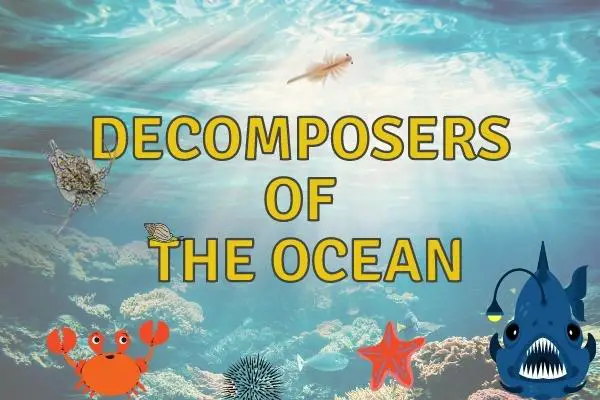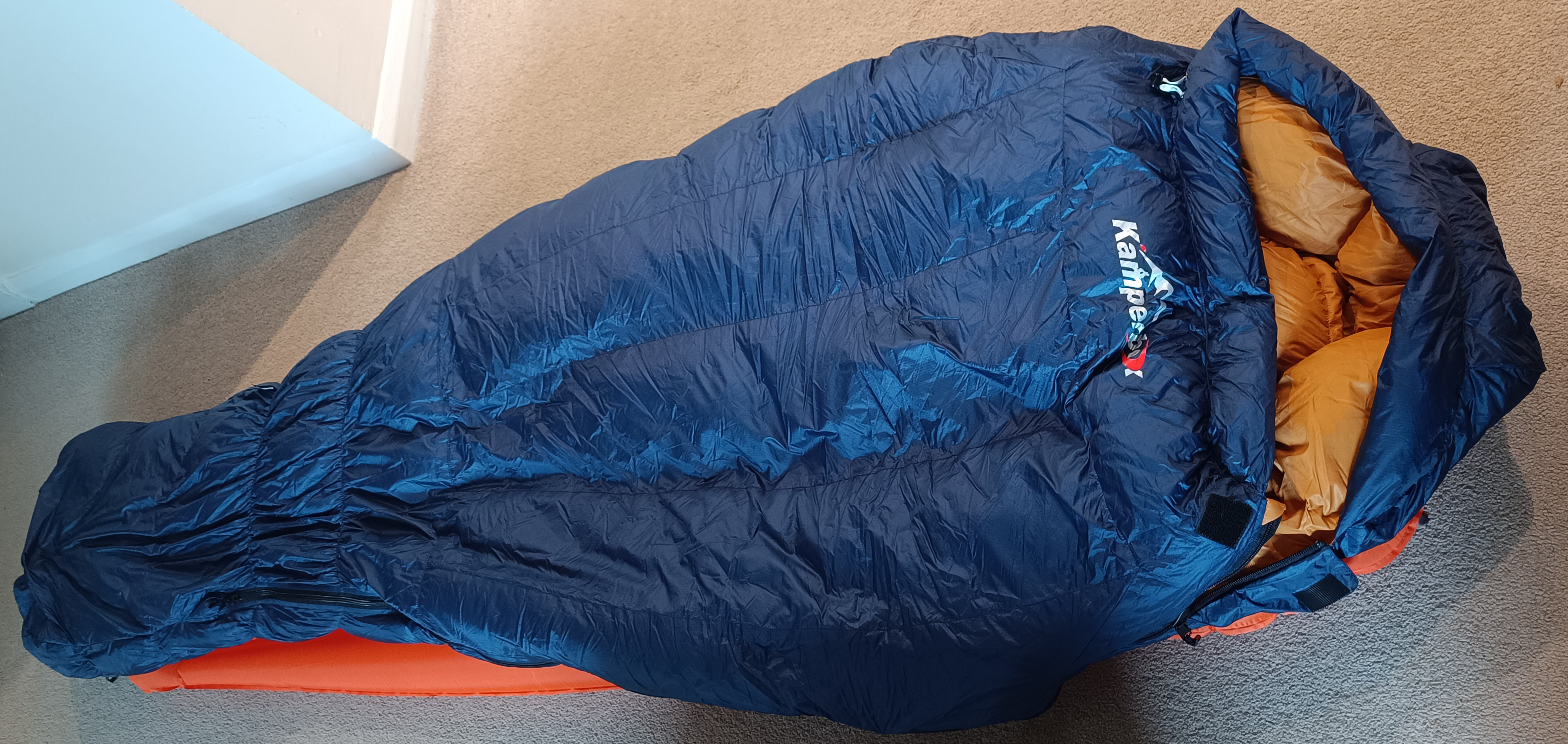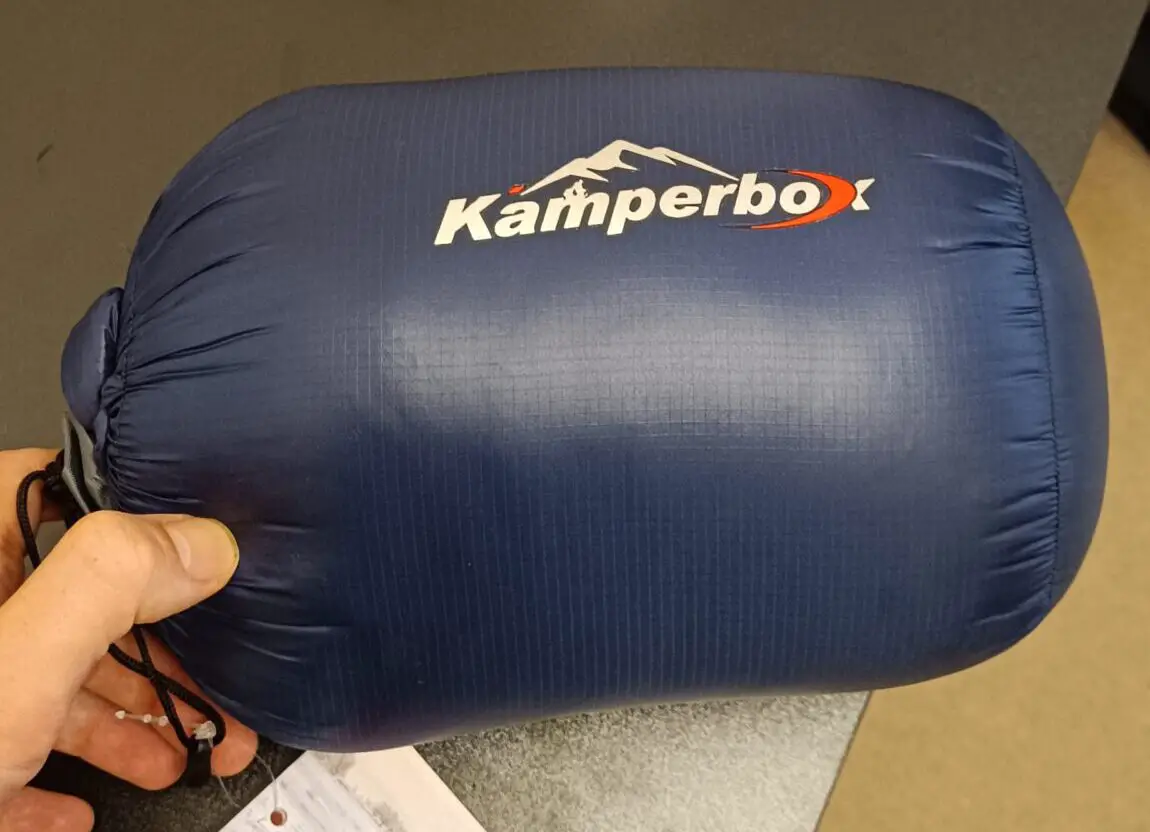Decomposers play an equally important role in marine ecosystems as they do in land ecosystems and they are just as numerous and diverse!
In the ocean, the most abundant decomposers are bacteria, marine worms, Echinoderms, Crustaceans and Mollusks. They all get their energy by breaking down dead organic matter that float around or fall to the bottom of the sea.
Different decomposers are adapted to survive in different marine ecosystems that are a result of the different conditions in different oceans and different parts (niches) of each ocean.
In oceans, the distribution of organisms, and therefore the distribution of organic waste and decomposers, is uneven over different parts of the ocean.
For example, the decomposers found in a coral reef located in shallow waters are different than those found in the deep sea parts of the ocean!
Warmer and shallower waters contain more life, and therefore more organic waste and decomposers, than deeper, colder waters1.
Contents
What are the Top 5 Decomposers in the Ocean?
The most common decomposers in the ocean can be summarized as micro decomposers, marine worms, echinoderms, crustaceans, and mollusks.
1. Micro Decomposers
The microscopic decomposers found in oceans often receive the least attention for the greatest amount of work!
Micro decomposers in the ocean include bacteria and fungi and are the most important group of decomposers. Microscopic animals called protists or zooplankton can also be decomposers – or producers like the hybrid organism Euglena!
As we will see, chemosynthetic bacteria can also be regarded as decomposers to some degree.

These microorganisms can be found in all marine ecosystems and feed on a wide variety of organic material.
2. Marine Worms
Marine worms are a diverse group of organisms, including decomposers like Christmas tree worms and feather duster worms.
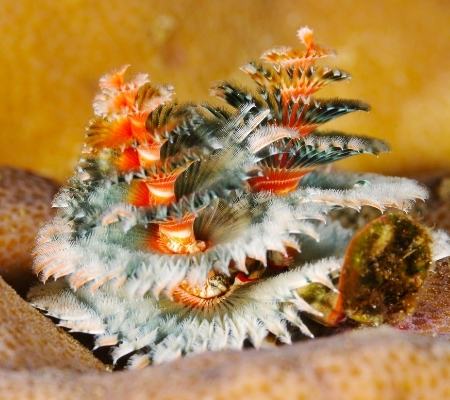
They are sedentary filter feeders with appendages that spread out and catch small organic particles suspended in the water. They can be found in coral reefs and intertidal rock pools.
3. Echinoderms
Unlike the sedentary marine worms, echinoderms, such as starfish, brittle stars, sea urchins and sea cucumbers, actively seek out dead organic matter on rocks and other surfaces.
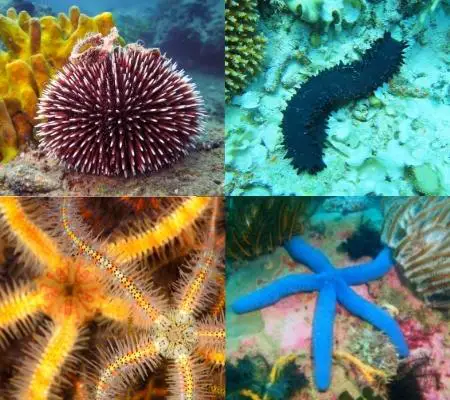
Many echinoderms are opportunistic carrion feeders or detritivores. Echinoderms are mostly found in shallow waters, like coral reefs and intertidal rock pools, but can also be found in deeper waters.
4. Crustaceans
Crustaceans can be found in all parts of the ocean. Crustaceans include crabs, shrimp, lobsters and even barnacles can function as decomposers.
Sessile crustaceans, like barnacles, feed on small organic particles suspended in the water, while more mobile species like crabs, shrimp and lobsters actively forage for food.

Crabs are opportunistic feeders and will eat almost anything they come across, including carrion, pieces of seaweed and small organic particles they sift out of the sand.
For example, barnacles live on intertidal rocks, but giant Japanese spider crabs are found in the deep sea.
5. Mollusks
Mollusks include mussels, clams, oysters, and snails. Sessile mollusks are filter feeders that feed on small organic particles suspended in the water.
Snails are important carrion feeders but can also feed on plant material or small organic particles in the sand.

Most mollusks prefer shallower waters. Mussels eat some dead organic material and can be found on intertidal rocks.
Giant clams live in coral reefs. Snails can be found on intertidal rocks, in coral reefs, or buried in the sand of beaches or the ocean floor.
Lastly, while no fish are decomposers in the classical sense, many fish are scavengers that help recycle dead plant and animal material on the bottom of fresh and saltwater habitats! Read more about them here!
What are Some Decomposers in the Deep Ocean?
A few specialized decomposers are adapted to survive the cold, dark ocean depths.
Since no photosynthesis can take place, deep ocean ecosystems have low levels of organic matter and mostly rely on influx of organic matter from shallower waters.
Therefore, decomposers are few and far between, either remaining dormant for long periods of time, or travelling vast distances in search of food.
Occasionally, a large carcass, like that of a whale, sinks down to the bottom of the ocean, providing a large food source and creating a hub of activity in the deep ocean.
After large scavengers, such some fish including Greenland sharks and crustaceans like crabs, have removed most of the soft tissue, the decomposers take care of the rest.
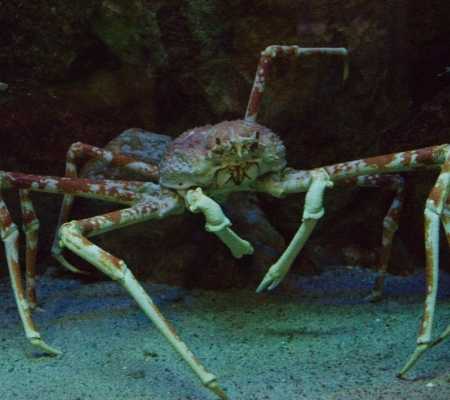
Smaller animals like bristle worms, snails, limpets, clams, mussels, and small shrimp feed on the remaining soft tissue until only bones are left.
Bone-eating worms bore into bones to extract lipids, contributing to the breakdown of the bones.
Subsequently, sulfur-loving chemosynthetic bacteria obtain their energy from the sulfur released as the bones decompose.2
What Kind of Bacteria are Decomposers in the Ocean?
Whereas the sulfur-loving bacteria often found around whale carcasses and thermal vents mentioned above create their own energy via a process known as chemosynthesis, most bacterial species in the ocean are true heterotrophic decomposers.
A true decomposer in the more classical sense feeds directly on dead plants and animals and decompose the dead organic matter into nutrients directly available for producers.
Decomposing bacteria in the ocean include ammonium and nitrite oxidizing bacteria as well as numerous heterotrophic species that eat decaying organism directly.
Ammonium is one of the biggest waste products of fish3. Ammonium oxidizing bacteria break down ammonium to nitrite, which is then further broken down to nitrate by nitrite oxidizing bacteria4.
Nitrate is an important nutrient for phytoplankton, algae and other primary producers to grow and reproduce.

Many of the same anaerobic heterotrophic bacteria known from decomposition of organic material on land are also found in the ocean.
Heterotrophic bacteria such as Alteromonas play an important role in decomposing dissolved organic carbon from feces and decaying organisms in the ocean5.
Most bacterial decomposers are found in the darker parts of the ocean, e.g. the deep sea or underneath the sea bed, as those found in the shallower waters are likely to be producers such as Cyanobacteria that get their energy from photosynthesis rather than decomposing or consuming other organism.
What kind of Fungi are Decomposers in the Ocean?
Fungi are not just terrestrial organisms, but can also be found in aquatic ecosystems where they feed in much the same way as they do on land.
Marine fungi can be found in many different places, from the depths of the ocean to mangrove swamps.
There are three types of marine fungi: harmless decomposers that eat dead organic matter, symbiotic fungi that live in harmony with their host, and parasitic ones that feed on animals or plants.
Most marine fungi are found in symbiotic relationships with organisms like algae, coral, sponges, marine invertebrates and mammals6, 7.
Several microscopic fungi species are found in ocean sediments where they break down small organic particles6.
As in terrestrial environments, wood-decaying fungi play a big role in the decomposition of driftwood in the ocean, especially in mangrove forests that contain lots of wood6.
Marine fungi decompose both plant and animal matter of the seabed and are an important part of the marine food web.
This is because they are able to decompose the tough cell walls of algae and other seaweeds and plants, as well as the hard shells of crabs and lobsters.
Fungi use an enzyme called chitinase to decompose the chitin shells of crabs, lobsters, sea urchins, and an enzyme called laccase to break down the lignin making up a large part of the cell walls in plants.
Other important marine fungi decomposers include wood-degrading fungi, which need to be able to break down the strong cellulose used in plant cell walls in order to decompose the wood.
There are even actual mushrooms growing underwater like the Psathyrella aquatica found in some rivers.
What Other Animals are Decomposers in the Ocean?
Interestingly, some birds like adult flamingos that are essentially filter feeders can also be regarded as decomposers (although mostly consumers) as they use their fancy beak to filter out small organic particles from the water to eat!
Are starfish producers, consumers or decomposers?
Because starfish eat other organisms, they are consumers and can be decomposers. Most starfish are predators of live prey like mollusks, crustaceans, and coral, but they will opportunistically feed on carrion and some starfish specifically eat dead organic debris8.
Starfish are not producers, because they cannot produce their own food.
How are mollusks decomposers in the ocean?
Sedentary mollusks like clams, mussels and oysters are generally filter feeders8.
They suck water in through their siphons and use their gills to filter out small organic particles from the water – including dead organic matter.
Snails can be either filter feeders or active foragers. As decomposers, they feed directly on leaf litter or carrion.
What crustaceans are decomposers in the ocean?
Well known crustaceans like crabs, lobsters, shrimp, and barnacles are all decomposers in the ocean.
Other important decomposers include less well-known crustaceans like sea louse and microscopic planktonic crustaceans such as krill or water fleas8.
Are sea urchins decomposers?
Most of the spiny sea urchins found in rock pools are grazers of algae, but the flattened sand-dwelling forms, such as the pansy shell, do function as decomposers as they feed on small organic particles in the sand8. All sea urchins are quite important to the marine ecosystem, because they control the growth of micro algae and other planktons.
Are green algae decomposers?
Green algae, such as sea lettuce and seaweed, are producers and not decomposers8. Algae resemble plants in many ways, including their ability to photosynthesize, and play a similar role in marine ecosystems as plants do in terrestrial ecosystems.
Why are sea cucumbers decomposers?
Sea cucumbers are decomposers because they feed on dead organic particles, detritus and plankton.
They have feeding tentacles that can pick up food from sand or rock as they move around or filter out food particles suspended in the water while they remain attached to a solid surface.8
Are sea anemones decomposers?
Sea anemones are not decomposers since they mostly predate on live animals, such as small crustaceans and mollusks, which get trapped by their stinging tentacles. Additionally, some anemones get nutrients from host symbiotic algae.8
Conclusion
Apart from starfish, mollusks, crustaceans, sea urchins, and sea cucumbers, there are many microscopic decomposers such as bacteria, protists and fungi.
In fact, just like in terrestrial ecosystems, microorganisms are likely the most important decomposers in all oceanic ecosystems.
Did you miss something in this article? Maybe weather jellyfish can be decomposers in the ocean – check out my other articles below!
References:
- Biologydictionary.net Editors. 2017. Decomposers in the Ocean. Biologydictionary.net. https://biologydictionary.net/decomposers-in-the-ocean/
- Anderson, S. 2015. Decomposition in the deep sea. Oceanbites.org. https://oceanbites.org/decomposition-in-the-deep-sea/
- Randall, D.J., Wright, P.A. 1987. Ammonia distribution and excretion in fish. Fish Physiol Biochem, 3:107–120. https://doi.org/10.1007/BF02180412
- Center for microbial oceanography: research and education. Marine Microbes. https://hahana.soest.hawaii.edu/cmoreserver/cruises/biolincs/microbes.htm
- Pedler, B.E., ALuwihare, L.I., Azam, F. 2014. Single bacterial strain capable of significant contribution to carbon cycling in the surface ocean. PNAS, 111 (20): 7202-7207. https://doi.org/10.1073/pnas.1401887111
- Gladfelter AS, James TY, Amend AS. 2019. Marine fungi. Current Biology, 29 (6): R191-R195. https://doi.org/10.1016/j.cub.2019.02.009
- Amend, A., Burguad, G., Cunliffe, M., Edgcomb, V.P., et al. 2019. Fungi in the Marine Environment: Open Questions and Unsolved Problems. mBio, 10 (2): e01189-18. https://doi.org/10.1128/mBio.01189-18
- Branch GM, Griffiths CL, Branch ML, Beckley LE. 2007. Two Oceans – A guide to the marine life of southern Africa. Struik, Cape town, South Africa. 359 pp.

